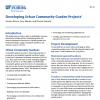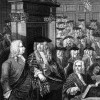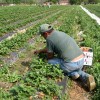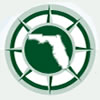 Distance education allows organizations to reach broader audiences, reduce costs per learner, and better serve communities. This 4-page fact sheet discusses how to incorporate the best practices for engaging learners in online distance education programs. Written by Austen Moore and Amy Harder, and published by the UF Department of Agricultural Education and Communication, May 2013.
Distance education allows organizations to reach broader audiences, reduce costs per learner, and better serve communities. This 4-page fact sheet discusses how to incorporate the best practices for engaging learners in online distance education programs. Written by Austen Moore and Amy Harder, and published by the UF Department of Agricultural Education and Communication, May 2013.
http://edis.ifas.ufl.edu/wc142
Tag: Agricultural Education and Communication Department
A Cooperative Agreement and the Implementation of the Endangered Species Act: How Extension Can Facilitate Stakeholder Involvement and Compliance
 This 4-page fact sheet provides a brief description of the Endangered Species Act and updated action pertaining to the endangered species issue. The goal of this publication is to provide brief but clear information about the legislation and current agreements around this issue that Extension agents can use to increase educated conversations. Written by Chandra Bowden, Alexa Lamm, Tracy Irani, and Sebastian Galindo, and published by the UF Department of Agricultural Education and Communication, May 2013.
This 4-page fact sheet provides a brief description of the Endangered Species Act and updated action pertaining to the endangered species issue. The goal of this publication is to provide brief but clear information about the legislation and current agreements around this issue that Extension agents can use to increase educated conversations. Written by Chandra Bowden, Alexa Lamm, Tracy Irani, and Sebastian Galindo, and published by the UF Department of Agricultural Education and Communication, May 2013.
http://edis.ifas.ufl.edu/wc141
Reusable Learning Objects: Tools for Teaching in Nonformal Education (WC140)
 Reusable learning objects are short, self-contained, digital learning activities that can be valuable tools for sharing information. This 4-page fact sheet provides a brief synopsis of what reusable learning objects are and how to create an them for use in an educational setting. Written by Jessica L. Gouldthorpe, Amy Harder, T. Grady Roberts, and Nicole Stedman, and published by the UF Department of Agricultural Education and Communication, April 2013.
Reusable learning objects are short, self-contained, digital learning activities that can be valuable tools for sharing information. This 4-page fact sheet provides a brief synopsis of what reusable learning objects are and how to create an them for use in an educational setting. Written by Jessica L. Gouldthorpe, Amy Harder, T. Grady Roberts, and Nicole Stedman, and published by the UF Department of Agricultural Education and Communication, April 2013.
http://edis.ifas.ufl.edu/wc140
Developing Urban Community Garden Projects (WC139)
 Community gardens are pieces of land where groups of people grow and maintain vegetable and flower plants. They exist in all types of areas, including neighborhoods, at schools, or on other public or private lands. Community gardens grow food for local consumption or sale and can also be used for teaching gardening and other skills This 7-page fact sheet provides a guide to individuals or groups interested in starting urban community gardens and includes information about how to identify garden sites, build partnerships, engage community members, and develop a project overview. Written by Austen Moore, Amy Harder, and Norma Samuel, and published by the UF Department of Agricultural Education and Communication, March 2013.
Community gardens are pieces of land where groups of people grow and maintain vegetable and flower plants. They exist in all types of areas, including neighborhoods, at schools, or on other public or private lands. Community gardens grow food for local consumption or sale and can also be used for teaching gardening and other skills This 7-page fact sheet provides a guide to individuals or groups interested in starting urban community gardens and includes information about how to identify garden sites, build partnerships, engage community members, and develop a project overview. Written by Austen Moore, Amy Harder, and Norma Samuel, and published by the UF Department of Agricultural Education and Communication, March 2013.
http://edis.ifas.ufl.edu/wc139
Being Smart About Gluten and Gluten-Free Issues, Part 1: What Are the Health Concerns Surrounding Gluten? (WC133/WC133)
 Are you an inquisitive consumer who asks what the big deal is about gluten free? Ask no more; this article is the first in a three–part series about gluten. This 7-page fact sheet identifies health conditions surrounding the ingestion of gluten. The resources used in this article are research and evidence based and/or peer reviewed to provide straightforward and simple information about a few gluten-related topics. Written by Abigail Dicks, Amy Harder, and Amy Simonne, and published by the UF Department of Agricultural Education and Communication, January 2013.
Are you an inquisitive consumer who asks what the big deal is about gluten free? Ask no more; this article is the first in a three–part series about gluten. This 7-page fact sheet identifies health conditions surrounding the ingestion of gluten. The resources used in this article are research and evidence based and/or peer reviewed to provide straightforward and simple information about a few gluten-related topics. Written by Abigail Dicks, Amy Harder, and Amy Simonne, and published by the UF Department of Agricultural Education and Communication, January 2013.
http://edis.ifas.ufl.edu/wc133
Parliamentary Procedure: Previous Question (WC138)
 The motion Previous Question is used to immediately close debate and to prevent the making of all subsidiary motions, except for the motion to Lay on the Table. Ordering the Previous Question does not prevent the making of any privileged or incidental motions, has no effect on the last question considered by the assembly, and is not allowed in committees. This 2-page fact sheet was written by Agricultural Education and Communication, and published by the UF Department of James E. Dyer, January 2013.
The motion Previous Question is used to immediately close debate and to prevent the making of all subsidiary motions, except for the motion to Lay on the Table. Ordering the Previous Question does not prevent the making of any privileged or incidental motions, has no effect on the last question considered by the assembly, and is not allowed in committees. This 2-page fact sheet was written by Agricultural Education and Communication, and published by the UF Department of James E. Dyer, January 2013.
http://edis.ifas.ufl.edu/wc138
Parliamentary Procedure: Lay on the Table (WC137)
 The motion to Lay on the Table is used to temporarily delay action on a pending question while something else of immediate urgency needs consideration, or when another item of business needs to be addressed before consideration of the pending question. This 2-page fact sheet was written by Agricultural Education and Communication, and published by the UF Department of James E. Dyer, January 2013.
The motion to Lay on the Table is used to temporarily delay action on a pending question while something else of immediate urgency needs consideration, or when another item of business needs to be addressed before consideration of the pending question. This 2-page fact sheet was written by Agricultural Education and Communication, and published by the UF Department of James E. Dyer, January 2013.
http://edis.ifas.ufl.edu/wc137
Parliamentary Procedure: Preparing Minutes of a Meeting (WC136)
 An official copy of the minutes of a meeting should be kept in a manner that is accessible to the membership, yet preserves their integrity as a historical record of the organization. This 4-page fact sheet was written by Agricultural Education and Communication, and published by the UF Department of James E. Dyer, January 2013.
An official copy of the minutes of a meeting should be kept in a manner that is accessible to the membership, yet preserves their integrity as a historical record of the organization. This 4-page fact sheet was written by Agricultural Education and Communication, and published by the UF Department of James E. Dyer, January 2013.
http://edis.ifas.ufl.edu/wc136
Reconciling Immigration and Agricultural Labor Concerns for a Sustainable State Economy (WC132)
 Immigration in Florida is a contested issue, and having an understanding of this issue can help facilitate communication. This 6-page fact sheet provide brief but clear information about the trends in policies that can be used by Extension agents to increase educated conversations around immigration issues. Written by Agricultural Education and Communication, and published by the UF Department of Chandra Bowden, Alexa Lamm, Hannah Carter, Tracy Irani, and Sebastian Galindo, December 2012.
Immigration in Florida is a contested issue, and having an understanding of this issue can help facilitate communication. This 6-page fact sheet provide brief but clear information about the trends in policies that can be used by Extension agents to increase educated conversations around immigration issues. Written by Agricultural Education and Communication, and published by the UF Department of Chandra Bowden, Alexa Lamm, Hannah Carter, Tracy Irani, and Sebastian Galindo, December 2012.
http://edis.ifas.ufl.edu/wc132
Capturing Change: Comparing Pretest-Posttest and Retrospective Evaluation Methods (WC135)
 Two models that are commonly used in Extension programming to capture change over a short period of time are the pretest-posttest model and the retrospective pretest (or post-then-pre) model. When deciding which model to use, Extension professionals should keep in mind that each participant has a knowledge base that includes both factual information and perceptions pertaining to factual information. As you read about the strengths and weaknesses of these two design models, consider how each model fits the evaluation situation to select the one that can best measure change in your program. This 4-page fact sheet was written by Agricultural Education and Communication, and published by the UF Department of Jessica L. Gouldthorpe and Glenn D. Israel, January 2013.
Two models that are commonly used in Extension programming to capture change over a short period of time are the pretest-posttest model and the retrospective pretest (or post-then-pre) model. When deciding which model to use, Extension professionals should keep in mind that each participant has a knowledge base that includes both factual information and perceptions pertaining to factual information. As you read about the strengths and weaknesses of these two design models, consider how each model fits the evaluation situation to select the one that can best measure change in your program. This 4-page fact sheet was written by Agricultural Education and Communication, and published by the UF Department of Jessica L. Gouldthorpe and Glenn D. Israel, January 2013.
http://edis.ifas.ufl.edu/wc135
Finding Grant Opportunities to Support County Extension Programs (WC134)
 This 3-page fact sheet presents information about where to look for grant opportunities, what to look for when reviewing grant opportunities, and how to determine if the opportunity fits your idea. Written by Amy Harder, Alexa Lamm, and Sebastian Galindo, and published by the UF Department of Agricultural Education and Communication, December 2012.
This 3-page fact sheet presents information about where to look for grant opportunities, what to look for when reviewing grant opportunities, and how to determine if the opportunity fits your idea. Written by Amy Harder, Alexa Lamm, and Sebastian Galindo, and published by the UF Department of Agricultural Education and Communication, December 2012.
http://edis.ifas.ufl.edu/wc134
The Establishment of Agricultural Leadership Programs and the International Association of Programs for Agricultural Leadership (WC121)
 The Kellogg Farmers Study Program established agricultural leadership programs in 1965. Today these programs, which are part of the International
The Kellogg Farmers Study Program established agricultural leadership programs in 1965. Today these programs, which are part of the International
Association of Programs for Agricultural Leadership, are used around the world to develop leaders for “continued or future service to their
community—rural, agricultural, or otherwise.” This 3-page fact sheet was written by Hannah Carter and Avery Culbertson, and published by the UF Department of Agricultural Education and Communication, October 2012.
http://edis.ifas.ufl.edu/wc121
The Wedgworth Leadership Institute for Agriculture and Natural Resources (WC120)
 The Wedgworth Leadership Institute for Agriculture and Natural Resources (WLIANR) develops and refines the leadership capabilities of leaders involved in Florida agriculture and natural resources. These leaders are prepared to become increasingly involved in forming policies that affect the future of Florida agriculture and natural resources in a direct or indirect manner. This 2-page fact sheet was written by Hannah Carter and Rochelle Strickland, and published by the UF Department of Agricultural Education and Communication, October 2012.
The Wedgworth Leadership Institute for Agriculture and Natural Resources (WLIANR) develops and refines the leadership capabilities of leaders involved in Florida agriculture and natural resources. These leaders are prepared to become increasingly involved in forming policies that affect the future of Florida agriculture and natural resources in a direct or indirect manner. This 2-page fact sheet was written by Hannah Carter and Rochelle Strickland, and published by the UF Department of Agricultural Education and Communication, October 2012.
http://edis.ifas.ufl.edu/wc120
Instructional Methods for Distance Education (AEC345/WC026)
 Much of the time, teaching with distance education technologies is a matter of adapting the teaching styles and instructional methods teachers have been using for years in the traditional classroom. This 5-page fact sheet applies basic teaching principles to distance education technologies. Written by Ricky W. Telg, and published by the UF Department of Agricultural Education and Communication, September 2012.
Much of the time, teaching with distance education technologies is a matter of adapting the teaching styles and instructional methods teachers have been using for years in the traditional classroom. This 5-page fact sheet applies basic teaching principles to distance education technologies. Written by Ricky W. Telg, and published by the UF Department of Agricultural Education and Communication, September 2012.
http://edis.ifas.ufl.edu/wc026
Brochures and Newsletters (WC131)
 Brochures are small, usually folded documents used to inform, educate, or persuade the reader. They are commonly used to promote organizations, products, or events. Brochures attract attention through eye-catching design. Brochures must contain clear, concise, focused writing because they are so short. When writing and designing a brochure, incorporating these recommendations can contribute greatly to your document’s overall effect. This 4-page fact sheet was written by Ricky Telg, and published by the UF Department of Agricultural Education and Communication, June2012.
Brochures are small, usually folded documents used to inform, educate, or persuade the reader. They are commonly used to promote organizations, products, or events. Brochures attract attention through eye-catching design. Brochures must contain clear, concise, focused writing because they are so short. When writing and designing a brochure, incorporating these recommendations can contribute greatly to your document’s overall effect. This 4-page fact sheet was written by Ricky Telg, and published by the UF Department of Agricultural Education and Communication, June2012.
http://edis.ifas.ufl.edu/wc131
Graphic File Formats (WC130)
 When designing documents, you have to be aware of the different types of images you may receive. This 2-page fact sheet provides an overview of raster graphics and vector graphics. Written by Ricky Telg, and published by the UF Department of Agricultural Education and Communication, June 2012.
When designing documents, you have to be aware of the different types of images you may receive. This 2-page fact sheet provides an overview of raster graphics and vector graphics. Written by Ricky Telg, and published by the UF Department of Agricultural Education and Communication, June 2012.
http://edis.ifas.ufl.edu/wc130
Elements of Document Design (WC129)
 Where the principles of document design provide considerations for overall document layout, the elements of document design focus on these specific visual elements that make up the visual content of the document: text and typefaces, visuals, graphics, color, and white space. This 4-page fact sheet was written by Ricky Telg, and published by the UF Department of Agricultural Education and Communication, June 2012. http://edis.ifas.ufl.edu/wc129
Where the principles of document design provide considerations for overall document layout, the elements of document design focus on these specific visual elements that make up the visual content of the document: text and typefaces, visuals, graphics, color, and white space. This 4-page fact sheet was written by Ricky Telg, and published by the UF Department of Agricultural Education and Communication, June 2012. http://edis.ifas.ufl.edu/wc129
Principles of Document Design (WC128)
 Good design does not call attention to itself, but good designers use the principles of document design to make sure their layouts look pleasing and attractive. The principles of document design are balance, proportion, order, contrast, similarity, and unity. This 3-page fact sheet was written by Ricky Telg, and published by the UF Department of Agricultural Education and Communication, June 2012.
Good design does not call attention to itself, but good designers use the principles of document design to make sure their layouts look pleasing and attractive. The principles of document design are balance, proportion, order, contrast, similarity, and unity. This 3-page fact sheet was written by Ricky Telg, and published by the UF Department of Agricultural Education and Communication, June 2012.
http://edis.ifas.ufl.edu/wc128
Document Design (WC127)
 Document design is the process of choosing how to present all of the basic document elements so your document’s message is clear and effective. When a document is well designed, readers understand the information more quickly and easily. Readers feel more positive about the topic and more accepting of its message. This 3-page fact sheet was written by Ricky Telg, and published by the UF Department of Agricultural Education and Communication, June 2012.
Document design is the process of choosing how to present all of the basic document elements so your document’s message is clear and effective. When a document is well designed, readers understand the information more quickly and easily. Readers feel more positive about the topic and more accepting of its message. This 3-page fact sheet was written by Ricky Telg, and published by the UF Department of Agricultural Education and Communication, June 2012.
http://edis.ifas.ufl.edu/wc127
Video Editing (WC126)
 Editing a video is a creative process where you put all the various parts together into one comprehensive program. Video editing software programs allow you to make changes easily. This 2-page fact sheet introduces the concept of video editing. Written by Ricky Telg, and published by the UF Department of Agricultural Education and Communication, June 2012.
Editing a video is a creative process where you put all the various parts together into one comprehensive program. Video editing software programs allow you to make changes easily. This 2-page fact sheet introduces the concept of video editing. Written by Ricky Telg, and published by the UF Department of Agricultural Education and Communication, June 2012.
http://edis.ifas.ufl.edu/wc126